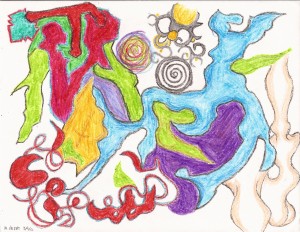Qur’anic Recitation Art (Week 3)
Since the Qur’an is believed to be the direct word of God, recitations of the Qur’an are considered divine experiences in and of themselves. In a sense, the listener is hearing God speak as “the actual sound [is that] of the Divine, the model of perfect beauty” (Nelson 257). A major crux of the Islamic religious experience is placed on this specific practice, yet Qur’anic recitations are highly subjective. The same sura can be read a multitude of different ways, emphasizing and highlighting different aspects of the same text.
I have synesthesia and associate sounds with very distinct images and visual motifs. Since “only in the sound [of the Qur’an] the full miracle is realized” (Nelson 258), I wanted to see what the “divine” looked like to me. Similarly, I was intrigued as to how five different recitations of the same text (Sura Al-Qadr) would manifest themselves in my visual art. Since I do not understand Arabic, I felt as if it would give me a pure visual image of the sounds and melodies uninfluenced by the meaning of the words.
The first recitation by Hajjah Maria Ulah manifested itself as the large, sky-blue shape in the middle of the picture. Ulah’s voice was nasally while similarly fluid and undulating. This inspired the fluid, rounded shapes. However, the repetitions of “Al-Qadr” were unexpected and abrupt, resulting in the sharp points at the tips of the undulations. The fluidity and fluctuation of the recitation evoked images of water, which influenced the blue coloring. I chose to shade the edges of the figure as the recitation sounded full and round, giving it an almost three dimensional appearance in my mind.
Ulah’s second reading came out as the multi-colored, turquoise, red and green shape in the upper left corner. The majority of the imagery came in the form of colors. I did draw some shapes, such as the zig-zag, turquoise square, representing the modulation and vibration of her voice, however I mostly saw pure colors in this reading. The coloring in this section was the deepest and most concentrated as the recitation was strong and loud. The quality of this recitation evoked the most visceral reaction within me. I found this recitation grating and unpleasurable, and it manifested itself in my drawings. The entire left corner of my picture is similarly not aesthetically pleasing.
The grey spirals and curls at the top of the picture represent Sheikh Abdul Basit Abdul Samad’s recitation. The reading was rounded and curling, manifesting themselves in the spiral shapes. The tinny, resonating quality of the recording evoked an image of metal and influenced the grey and silver coloring. Samad’s full voice sounded, “creamy” to me and became the yellow color that fills out the circles.
Sheikh Mahmoud Khalil Al Husary’s reading influenced the rounded, almost “flame” like shapes at bottom left corner. His reading was smoother with fewer abrupt pauses. The sounds flowed into one another, creating the rounded, smooth curves.
Seemi Bushra Ghazi’s reading became the tan curves at bottom right corner. The two words that embody Ghazi’s recitation in my mind are, “sensuous” and “voluptuous.” As soon as the recording started, I immediately saw shapes and colors similar to sand dunes I had seen in the Saharan Desert. I modeled this part of the picture after those.
Though all the recitations took on different forms and colors, there seemed to be a common shape that influenced all the depictions. Though I was not aware of it at the time, all five major shapes took on a similar “U” shaped formation. This may be due to the fact that they are all inspired by the same underlying sounds and text, suggesting that the divine, regardless of how it is conveyed or read, evokes consistent reactions.
